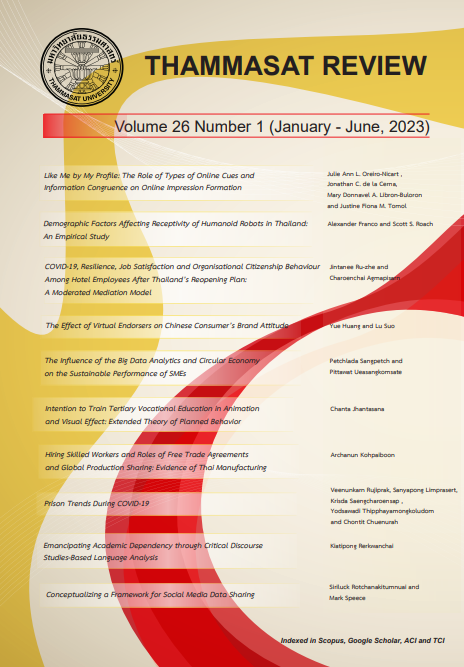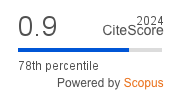The Effect of Virtual Endorsers on Chinese Consumer’s Brand Attitude
Keywords:
Advertising communication, Brand attitude, Parasocial interaction, Virtual endorserAbstract
A brand image endorser plays a crucial role in representing a company's public image. In comparison to celebrity endorsers, virtual endorsers offer the advantage of customization specifically tailored to corporate products or services. As technology advances and marketing methods continue to innovate, the study of consumer attitudes toward brands is gaining more and more attention. Based on Source Model theory and the Meaning Transfer Model, this study investigates the impact of virtual endorsers on consumers' brand attitudes in terms of three key characteristics: cuteness, professionalism, and relevance, as well as the indirect effect of parasocial interaction. A quantitative design was employed, utilizing online questionnaires to collect data through convenience sampling from 439 Chinese consumers over 18 who were familiar with the virtual endorsers. AMOS 23 software was employed to analyze data and test the hypotheses. The largest group of respondents were female consumers aged 26 – 30, with a bachelor's degree and a monthly income of 3,000-5,000 Chinese yuan, working in the private sector. The findings confirm that the cuteness and relevance of a brand's virtual endorser have a positive influence on consumers' brand attitudes. Additionally, parasocial interaction, as a mediating variable, was found to positively mediate the relationship between virtual endorsers (cuteness, professionalism, and relevance) and brand attitudes. This study offers novel perspectives and directions for further investigations related to virtual endorsers, and provides valuable marketing insights on how to create suitable virtual endorser images and enhance consumers' brand attitudes, thereby expanding the scope of advertising communication through virtual endorser endorsements.
References
Ahn, S. J., & Bailenson, J. N. (2011). Self-endorsing versus other-endorsing in virtual environments: the effect on brand attitude and purchase intention. Journal of Advertising, 40(2), 93-106. https://doi.org/10.2307/23048707.
Auter, P. J. (1992). TV that talks back: An experimental validation of a parasocial interaction scale. Journal of Broadcasting & Electronic Media. 36(2), 173-181. https://doi.org/ 10.1080/08838159209364165
Auter, P. J., & Palmgreen, P. (2000). Development and validation of a parasocial interaction measure: The audience‐persona interaction scale. Communication Research Reports, 17(1), 79-89. https://doi.org/10.1080/08824090009388753
Bagozzi, R. P., Lee, K.-H., & Van Loo, M. F. (2001). Decisions to donate bone marrow: The role of attitudes and subjective norms across cultures. Psychology & Health, 16(1), 29–56. https://doi.org/10.1080/08870440108405488
Baron, R. A. (1988). Negative effects of destructive criticism: Impact on conflict, self-efficacy, and task performance. Journal of Applied Psychology, 73(2), 199–207. https://doi. org/10.1037/0021-9010.73.2.199
Biesanz, J. C., Falk C. F., & Savalei, V. (2010) Assessing Mediational Models: Testing and interval estimation for indirect effects. Multivariate Behavioral Research. 45(4), 661-701. http://dx.doi.org/10.1080/00273171.2010.498292.
Brown, S.M.S. (2020). Let’s Get Virtual: Measuring Virtual Influencer’s Endorser Effectiveness. Dissertation. Texas A&M University. Texas, USA.
Brown, S. P. & Stayman, D. M. (1992). Antecedents and Consequences of Attitude Toward the Ad: A Meta-Analysis. Journal of Consumer Research, 19(1), 34-51. https://doi. org/10.1086/209284
Carsten, E., Henrik, S., & Oliver, S. (2015). How celebrity endorsers enhance parent brand extendibility to low similarity brand extensions. Journal of Business Economics, 85(5), 479-504. https://doi.org/10.1007/s11573-014-0743-3.
Chang, E. (2008). The Effectiveness of The Spokes-Character in Creating Brand Equity. In Society for Marketing Advances 2008 Conference.
Chey, C. & Piriyapada, S. (2022). The Influence of Celebrity Endorsement on Purchase Intention of Smartwatches in Cambodia. Journal of AEAN PLUS+ Studies, 3(2), 60-73.
Cochran, G. W. (1977). Sampling Techniques (third edition). New York, NY: John Wiley & Sons.
Dunk, A. S. (2004). Product life cycle cost analysis: the impact of customer profiling, competitive advantage, and quality of IS information. Management Accounting Research, 15(4), 401-414.
Engel, J. F., Blackwell, R. D., & Miniard, P. W. (1995) Consumer Behavior. 6th Edition, Dryden Press, Chicago, New York.
Fornell, C., & Larcker, D. F. (1981). Evaluating Structural Equation Models with Unobservable Variables and Measurement Error. Journal of Marketing Research, 18(1), 39–50. https://doi.org/10.2307/3151312
Garretson, J. A., & Niedrich, R. W. (2004). Spokes-Characters: Creating Character Trust and Positive Brand Attitudes. Journal of Advertising, 33(2), 25–36. http://www.jstor.org/ stable/4189255
Giles, D. C. (2002). Parasocial Interaction: A Review of the Literature and a Model for Future Research. Media Psychology, 4(3), 279-305. https://doi.org/10.1207/S1532785X MEP0403_04.
Hair, J. F., Anderson, R. E., Tatham, R. L., & Black, W. C. (1995). Multivariate data analysis. Englewood Cliffs, NJ: Prentice-Hall.
Han, X., Tang, Z.W., Tan, J., & Tu, W.q. (2016). Trust and identity: A study of class social interaction in government microblogs. Intelligence Journal, 35(11),106- 112.
Hankunaseth, S. & Nadee, W. (2022). An Analysis of YouTuber’s Collaboration towards Audience Engagement. In Proceedings of The International Conference on Electronic Business, Volume 22. ICEB’22, Bangkok, Thailand, October 13-17, 2022.
Hawkins, M., Motherbaugh, D. L., & Roger, J. Best. (2007). Consumer Behavior: Building Marketing Strategy. (10th ed.). Boston: McGraw-Hill
Horton, D., & Wohl, R. R. (1956). Mass communication and para-social interaction. Psychiatry: Journal for the Study of Interpersonal Processes, 19, 215–229.
Hovland, C., Janis, I., & Kelley, H. (1953). Communication and persuasion. New Haven, GT: Yale University Press.
Kinney, L., & Ireland, J. (2015). Brand Spokes-Characters as Twitter Marketing Tools. Journal of Interactive Advertising, 15(2), 135 - 150. https://doi.org/10.1080/15252019.2015.1101357
Knoll, J., Schramm, H., Schallhorn C, & Wynistorf, S. (2015). Good guy vs. bad guy: The influence of parasocial interactions with media characters on brand placement effects. International Journal of Advertising, 34(5), 720–743. https://doi.org/10.
/02650487.2015.1009350.
Kotler, P. and Keller, K. (2008) Marketing Management. 13th Edition, Prentice Hall, New Jersey.
Krech, D., Crutchfield, R. S., & Ballachey, E. L. (1962). Individual in society: A textbook of social psychology. McGraw-Hill.
Lafferty, B.A. (2007). The relevance of fit in a cause-brand alliance when consumers evaluate corporate credibility. Journal of Business Research, 60(5), 447-453. https://doi.org/ 10.1016/j.jbusres.2006.09.030
Lasswell, H. D. (1948). The structure and function of communication in society. In L. Bryson (Ed.), The communication of ideas (pp. 37-51). New York: Harper and Row.
Lu, M. R. (2019). How Influencers Affect Purchase Intentions Towards Endorsed Products: The Role of Influencers’ Match-Up with The Brand, Payment and Credibility. Master Thesis. ISCTE Business School of University of Lisbon. Lisboa, Portugal.
Luo, W., & Wang, X. (2011). A study on the scope of application of different types of brand spokespersons - based on the analysis of source trait theory. Journal of Xinxiang College (Social Science Edition), 25(2), 67-70.
McCracken, G. (1989). Who is the Celebrity Endorser? Cultural Foundations of the Endorsement Process. Journal of Consumer Research, 16(3), 310–321. http://www. jstor.org/stable/2489512
McGuire, W.J. (1985), Attitudes and attitude change. in Lindzey, G. and Aronson, E. (Eds.), The Handbook of Social Psychology, 2nd ed., Erlbaum, Hillsdale, New Jersey, pp. 262–276.
McQuail, D., Blumler, J.G., & Brown, J.R. (1972). The television audience: a revised perspective' in McQuail, D. (ed) Sociology of Mass Communications. Harmondsworth: Penguin. pp. 135-165.
Miller, F. M., & Allen, C. T. (2012). How does celebrity meaning transfer? Investigating the process of meaning transfer with celebrity affiliates and mature brands. Journal of Consumer Psychology, 22(3), 443–452. https://doi.org/10.1016/j.jcps.2011.11.00
Mize, J., & Kinney, L. (2008). Spokes-Character Influence on Brand Relationship Quality Factors. American Academy of Advertising Conference Proceedings, 177-187.
Natithamapimuke, A., & Nuangjamnong, C. (2022). Effecting of celebrity endorsement on customers’ attitude towards advertisement and purchase intention: a case study of a skincare soap in Thailand. AU eJournal of Interdisciplinary Research (ISSN: 2408-1906), 7(2), 1-11.
Nunnally, J.C. (1978). Psychometric Theory. 2nd. McGraw-Hill, New York.
Ohanian, R. (1990). Construction and Validation of a Scale to Measure Celebrity Endorsers’ Perceived Expertise, Trustworthiness, and Attractiveness. Journal of Advertising, 19(3), 39–52. http://www.jstor.org/stable/4188769
Ohanian, R. (1991). The impact of celebrity spokespersons' perceived image on consumers' intention to purchase. Journal of Advertising Research, 31(1), 46–54.
Pagla, M., & Brennan, R. (2014). The development of brand attitudes among young consumers. Marketing Intelligence & Planning, 32(6), 687-705. http://dx.doi.org/ 10.1108/MIP-08-2012-0077
Paul, W. B., & Brett, A. S. M. (2005). Forming Parasocial Relationships in Online Communities. in NA – Advances in Consumer Research Volume 32, eds. Geeta Menon and Akshay R. Rao, Duluth, MN: Association for Consumer Research, 197-201.
Pei, Y.M. (2022). Research on the Influence of Virtual Spokesperson on Consumer’s Brand Attitudes in Advertising Communication. Thesis. Hebei: Hebei University.
Peng, B., & Chao, G.L. (2011). Research on the role and selection of brand spokesperson on brand. Modern Management Science, 12, 17-19.
Rosenberg, M. J., Hovland, C. I., McGuire, W. J., Abelson, R. P., & Brehm, J. W. (1960). Attitude organization and change: An analysis of consistency among attitude components. (Yales studies in attitude and communication.). Yale University Press.
Rossiter, J. R., Percy, L., & Donovan, R. J. (1991). A better advertising planning grid. Journal of Advertising Research, 31(5), 11–21.
Rubin, A. M., Perse, E. M., & Powell, R. A. (1985). Loneliness, parasocial interaction, and local television news viewing. Human Communication Research, 12(2), 155–180. https://doi.org/10.1111/j.1468-2958.1985.tb00071.x
Sallam, M. A. A. (2012). Endorser Credibility Effects on Yemeni Male Consumer’s Attitudes towards Advertising, Brand Attitude and Purchase Intention: The Mediating Role of Attitude toward Brand. International Business Research. 5(4). 55-66. http://dx.doi.org/10.5539/ibr.v5n4p55
Sengupta J. P., Goodstein, R. C., & Boninger, D. S. (1997). All Cues Are Not Created Equal: Obtaining Attitude Persistence Under Low-Involvement Conditions. Journal of Consumer Research, 34 (March), 351–61.
Sha, Z. Q., & Zhou, D. T. (2013). A study of microblog-based social interaction between entrepreneurs and fans. Industrial Engineering and Management, 5,112-117.
Vidyanata, D., Sunaryo, S., & Hadiwidjojo, D. (2018). The Role of Brand Attitude and Brand Credibility as A Mediator of The Celebrity Endorsement Strategy to Generate Purchase Intention. Journal of Applied Management (JAM). 16(3). 402-411.
Wadhwa, B., & Chaihanchanchai, P. (2021). The Role of Online Influencer’s Characteristics in Attitude towards the Brand and Purchase Intention: A Case Study of L’Oréal. Communication And Media in Asia Pacific (CMAP). 4(2). 21-32. https://so01.tci-thaijo.org/index.php/CMAP
Xiao, M., Wang, R., & Chan-Olmsted, S. (2018). Factors affecting YouTube influencer marketing credibility: A heuristic-systematic model. Journal of Media Business Studies, 15(3), 188–213.
Zhang, N. (2013). Research on the impact of virtual endorsers on brand equity: the mediating role of brand experience and the moderating role of consumers' personal and product characteristics. Dissertation. Wuhan: Wuhan University.
Downloads
Published
How to Cite
Issue
Section
License
Copyright (c) 2023 Thammasat Review

This work is licensed under a Creative Commons Attribution-NonCommercial-NoDerivatives 4.0 International License.
The opinions and ideas expressed in all submissions published in Thammasat Review are solely that of the author(s) and do not necessarily reflect that of the editors or the editorial board.
The copyright of all articles including all written content and illustrations belong to Thammasat Review. Any individuals or organisation wishing to publish, reproduce and distribute a particular manuscript must seek permission from the journal first.








